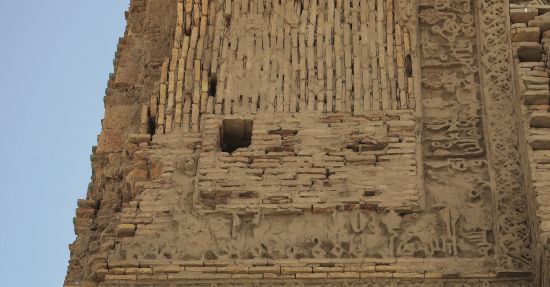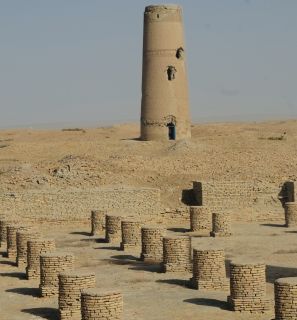Dehistan Cuma Mosque
Turkmenistan Dehistan 12th Century
Seljuk, Khwarazmian
The plan of the Dehistan Cuma Mosque, located in the center of the old city, came fully to light after excavation work. As a result of these excavations several shops and market places were found. Before the excavation, only the iwan and minaret were visible. The form of the plan played a major role in the development of Seljuk architecture. This mosque was built with the plan known as the M-site plan. This plan was the first mosque to be built using this plan. The Great Seljuks improved this plan and used it later in ıran. The layout consisted of a central space and a domed section in front of the and an iwan that led towards a central space.
On both sides of the domed section there are five parallel naves The iwan in front of the mihrab dome is richly decorated. The sanctuary section opens directly into the central space. This section is enclosed on all sides in a different manner on each side.Accordingly, the arcades around the atrium are three in the west and two each in the south and the north. An eye-catching pool is located in the middle of the central space. There is a minaret in the northeast comer of the mosque, and it narrows from bottom towards the top. A kufic inscription band on the minaret's shaft is visible in old photographs. The building's iwan has a rich decoration in terracotta and tile. Information about architect of the building is found in inscriptions located in this area. According to the inscriptions, the building was constructed by two men named Ebü'f Hussein bin Mohammad en-Nahhak and Mohammad bin Hussein en-Nahhak. Dehistan and it's surroundings fell under the control of the Seljuks in the late 11 th century. Later on, the region of Dehistan was ruled by governors appointed by the Seljuks. Later, the Khwarazmian leader Arslan il captured Dehistan and appointed his own administrators.
Cezar, M., Anadolu Öncesi Türklerde Şehir ve Mimarlık, lstanbul, 1977, s.145. Pugachenkova, G. A. Puti razvitya architektur Uzhnogo Turkmenistana pory rabovladenyia i feodalisma (Trends in the Architectural Development in South Turkmenistan at the Time of Slavery and Feudalism). Moskova, 1958, s.,264, 329. Pugaçenkova, G. A., iskusstvo Turkmenistana, Moskova, 1967, s.113.
Sayan, Y., Türkmenistan'daki Mimari Eserler (XI-XIV.yy.), Ankara, 1999, s. 47-49. Türkmen, F., "Mehmed Emin Efendi'nin Seyahatnamesi'ne Göre Eski Bir Türk Şehri: Dehistan·, Bilig, Sayı:49, 2009, s.205-218













